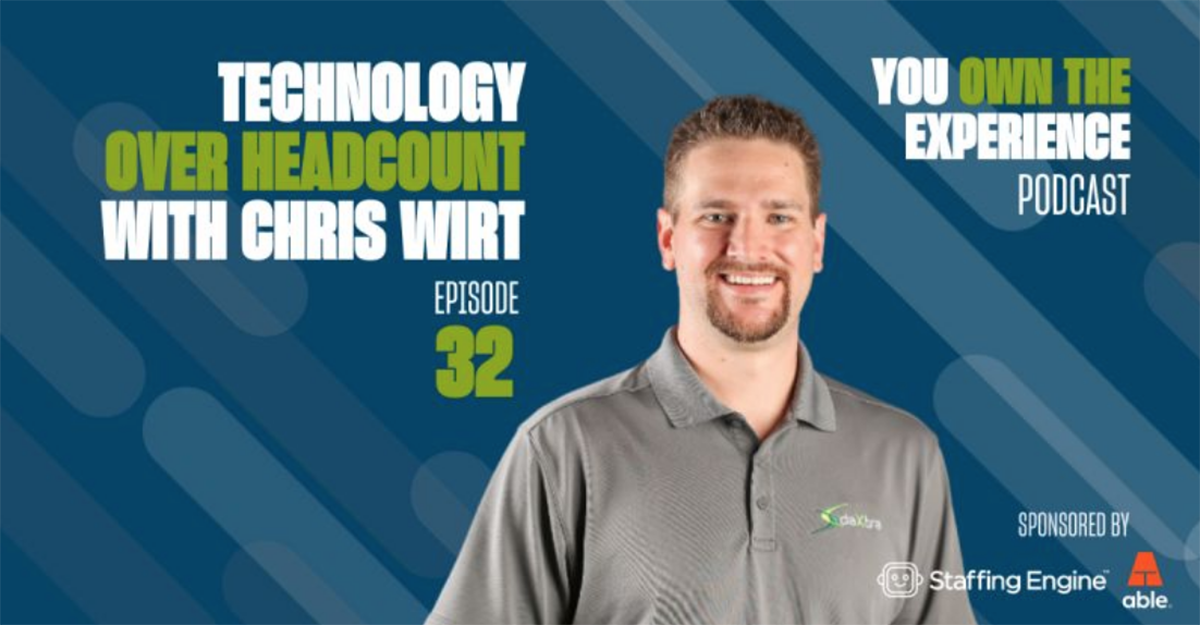Recently, podcast hosts Robert Mann and Lauren Jones sat down to discuss how recruitment technology works to automate processes and better utilize resources and spend. In Able’s You Own the Experience podcast, Episode 32, Technology Over Headcount, our own Chris Wirt joined the duo and shared his thoughts and experiences as an expert in the industry.
Delivering better data to your database and leveraging your marketing spend is the main focus of the podcast. This topic is as relevant to professionals who already use automation as it is to those who are new to automated solutions.
The first point the group touched upon was getting good data into your ATS or CRM. Bad data entering your system leads to an abundance of troublesome issues, while “good data leads to positive outcomes.” You must invest in comprehensive analytics tools to tell what’s happening within your ATS or CRM too. Without that, you're missing a piece of the puzzle.
The information gathered in a good analytics tool will give you the intelligence needed to help drive every action of your system. It will provide information on usage and adoption, it will help you see what is functioning well and what’s not working.
Lauren goes on to say that “Good data is going to make you money and it’s going to continue the cycle of intelligent investments.”
You’re not doing it right
Many in the industry have now built some type of automation tech stack, whether it be one solution or an extensive network of technology. But this is where it gets complicated. Many times challenges or difficulties have to do with lack of user adoption, or sometimes necessary protocols aren’t in place.
Chris refers to Matlen Silver, a DaXtra customer who was struggling with user adoption and not getting the return they had expected. They were ready to drop the solution when Amanda Marciniak joined their team and looked at things anew. As Director of Talent Acquisition and Training, she saw there were few analytics tools being used to analyze performance and return. When she took the helm she began to analyze processes and results and found that the product wasn’t being used to live up to its potential. There was also a lack of ongoing training in place. Once she implemented new protocols and stayed on top of analysis and training, things began to improve. A year later, they were thriving and continue to drive efficiencies with a continued rise in ROI.
Inefficiencies of marketing spend
Another facet of analytics is tracking your marketing spend. Seeing how your money is being spent and determining the best places to spend it going forward is crucial in calculating your return on investment.
Job board spend should be monitored and analyzed. You should have a “report card” on each vendor to record progress. Questions you should ask are:
- What job boards are you spending your money with?
- Are you utilizing the spend in the best way?
- How is each job board performing for you?
Many job board contracts have a tiered license program with a set number of profiles you can access, corresponding with a fee. Recruiters often “burn views” of candidate profiles but then fail to upload those candidates to the database. With automated parsing and loading in technology like DaXtra Capture you can count on 100% of the burned views of candidate profiles making it into your database. Additionally, the incoming data will be enriched with structured formatting and any duplicates already existing within your database will be updated.
This builds your database with good, clean, fully-enriched data. Different from electronic hoarding, which is just randomly grabbing data and pulling it into your system, the data gathered is targeted and meaningful. And the candidates that land in your system are of value.
Skills-based hiring and DEI
Search technology like DaXtra Search Nexus helps target specific candidates by intelligently searching for specified skills, certifications and qualifications. The AI behind this technology understands the context of a resume in a way a human would. It essentially “humanizes the process of searching your data by using natural language processing and machine learning” to understand the meaning behind the words on a resume.
It can conduct skills-based searches that help control biased decision-making by removing criteria like name, gender, and race. This can help companies meet their diversity goals.
Inventory check
As the podcast drew to a close Robert and Lauren concluded with the message to be aware of the Human Capital Inventory (HCI) in your database. The biggest deliverable of this inventory is the hidden information within the candidate data needed to make connections. This inventory holds the skills that connect people to jobs, and jobs to people, which is what this industry is all about.
Listen to the You Own the Experience podcast, Episode 32, Technology Over Headcount.



